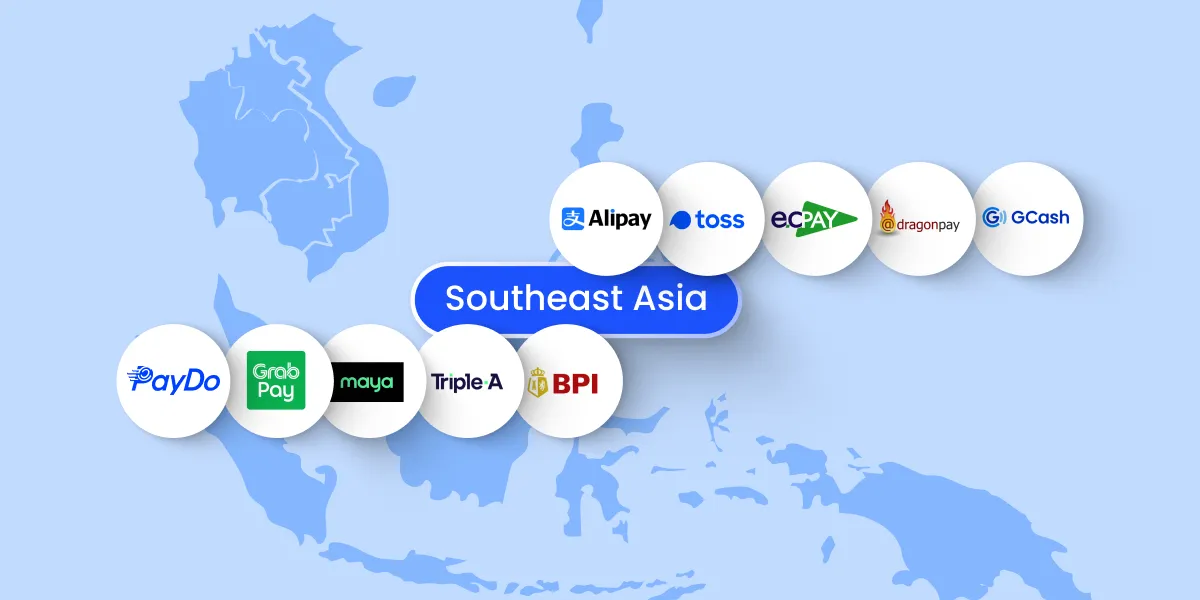E-commerce payment trends in Southeast Asia
Southeast Asia’s e-commerce sector is undergoing rapid transformation, driven by diverse economic landscapes, technological advancements, and a growing digital-savvy population. As consumers increasingly embrace online shopping, payment trends within the region have evolved to meet demand, offering various innovative solutions that cater to local preferences and regulatory environments. This article delves into the prominent e-commerce payment trends shaping Southeast Asia today.
1. Rise of digital wallets and mobile payments
Cash has long been the main payment method in Southeast Asia, a legacy of the vast unbanked population. However, digital wallets, with their convenience, security, and integration with loyalty programs, are rapidly becoming the preferred payment method.
According to research published by the Asian Development Bank last year, 58.4% of the e-commerce transactions in the Asia Pacific region were paid through digital or mobile wallets. This trend is even more pronounced in Southeast Asia, where companies like GrabPay and Dragonpay are experiencing phenomenal user growth.
This rise of digital wallets can be attributed to several factors. First, the high smartphone penetration rate makes mobile wallets easily accessible to a large population.
Second, digital wallets offer a smooth checkout experience, often requiring just a few clicks. Additionally, they provide transparency and security, allowing users to track their spending and benefit from fraud protection features.
Finally, digital wallets often have loyalty programs that offer cashback, discounts, and exclusive offers, further encouraging their use.
2. Local payment methods gaining popularity
The popularity of digital wallets in Southeast Asia does not negate the importance of understanding local preferences.

A significant portion of the population in countries like the Philippines and Indonesia remains unbanked. So, it is essential to offer local methods to overcome this fact and reflect the specific habits and preferences of different countries. For example, with the Philippines’ PayMaya, users can top up their digital wallets at convenience stores or via cash transactions and then make online purchases without a traditional bank account.
The success of local payment methods is also boosted by supportive regulatory frameworks. Governments are promoting digital payments to foster financial inclusion and boost economic growth. These efforts ensure local payment methods meet high security and operational standards, promoting consumer trust.
3. Cross-border payments
As Southeast Asian businesses expand beyond local markets, there is a growing demand for cross-border payment solutions that facilitate smooth and secure international transactions. Platforms like Alipay and WeChat Pay are at the forefront of these changes, offering services that enable transactions in multiple currencies, simplifying the process for merchants and consumers alike.
Regional cooperation is also an essential factor here. Initiatives like the ASEAN Payment Connectivity aim to integrate payment systems across Southeast Asian countries. The goal is to ensure compatibility among national payment infrastructures, facilitating smoother transactions across borders.
By lowering the barriers to cross-border payments, such efforts stimulate regional trade and open new business markets, fostering economic growth and diversification across the ASEAN bloc.
4. Cryptocurrency transaction
Cryptocurrencies are gaining popularity in Southeast Asia, offering a promising alternative for efficient and cost-effective transactions. They significantly reduce transaction costs by bypassing traditional financial intermediaries. This is particularly beneficial in a region characterised by diverse financial systems and varying levels of banking access, making cryptocurrencies an attractive option for cross-border transactions.
In terms of regulation, countries such as Singapore and Thailand are at the forefront of creating supportive environments for the use of cryptocurrencies. Singapore has developed a robust regulatory framework that supports cryptocurrency exchanges and fosters the broader blockchain ecosystem, ensuring consumer protection while encouraging innovation.
Thailand has also embraced cryptocurrencies, recognising them as a legitimate form of payment and introducing regulations to address associated risks like fraud and money laundering.
Read about cryptocurrency regulations around the world.
5. Social commerce
Social commerce is revolutionising e-commerce in Southeast Asia, capitalising on the region’s high social media engagement. Platforms like Facebook, Instagram, and TikTok now allow users to make purchases directly through their interfaces, simplifying the transition from browsing to buying.
Furthermore, integrating social commerce with mobile payments and digital wallets optimises transactions, allowing users to pay without leaving their social media apps. This simple process is particularly appealing in a region where many access the internet primarily via smartphones.
Learn more about e-commerce payment processing.
The e-commerce payment landscape in Southeast Asia is vibrant and diverse, mirroring the region’s dynamic economic and cultural structure. From digital wallets to innovative crypto solutions, these payment trends reflect changing consumer preferences, technological progress, and regulatory shifts. By integrating Payop’s solutions, you can stay up-to-date with the payment trends and earn the trust of your customers. Contact our team at sales@Payop.com to learn more.